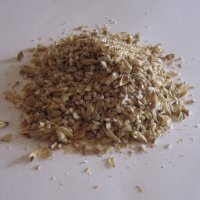Pilsner Malt

Description
Pilsner malt is a very pale malted barley intended for brewing Pilsner-style beer and other continental European styles. It is similar to other pale base malts like 2-row pale malt and 6-row pale malt, though it is often slightly lighter in color. In the past Pilsner malts were substantially undermodified and required a decoction mash for proper starch conversion. Generally, modern Pilsner malt is only marginally less modified than other malts and can be mashed in a simple infusion mash.
Pilsner malt imparts an unobtrusive and subtle malt flavor. Used alone it can produce very clean and crisp tasting beer that is extremely pale in color. When used with specialty grains it helps ensure a clear presentation of flavors without things becoming muddled.
Note on DMS: Due to very low temperature of kilning Pilsner malt contains more S-Methyl Methionine (SMM), which is converted to Dimethyl Sulfide (DMS) during mashing and fermentation. DMS is a sulfur compound that produces cooked corn off flavors at relatively low concentrations. Although a minimal DMS flavor contribution is considered desirable in many lager styles. DMS is volatile and can be largely eliminated by vigorous fermentation or boiling. Ales rarely have problems with DMS, but the slower rate of fermentation in lagers can allow DMS to accumulate. Special care should be taken when making lagers using large amounts of Pilsner malt (90 minutes of rolling boil, prompt chilling, and pitching a healthy yeast starter).
Beer Styles
As all or most of the grain in German and Czech Pilsner; base malt for many German styles including Kölsc, schwarzbier, Munich helles, and bock; base malt for many Belgian styles including blonde ale, dubbel, tripel, and saison; as well as other styles.
Malt Analysis
| Extract Potential | 1.037 |
| Color (°L) | 1.2 - 1.5 |
| DP (°Lin) | 140 |
| Protein (%) | 11.3 |
Statistical values aggregated from [1] and [2].
References
- ^ "Grains and Adjuncts Chart." Brew Your Own. n.d. Web. 7 June 2013. ‹http://www.byo.com/resources/grains›.
- ^ "Pilsen Malt: Malt Analysis Sheet." Briess Malt and Ingredient Co. n.d. Web. 7 June 2013. ‹http://www.brewingwithbriess.com›.

